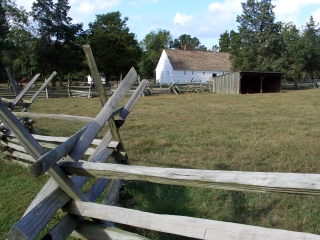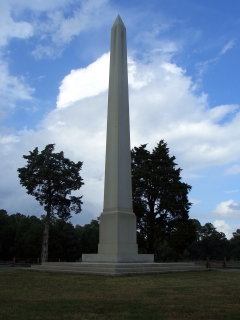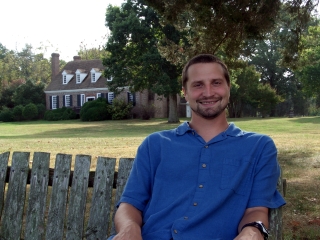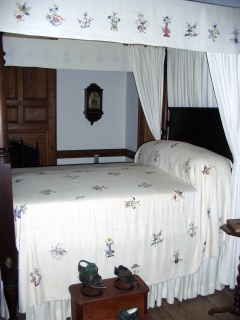NPS Website; Local Website
WHAT IS IT?
 Birthplace of George Washington, our first President, on either February 11 or 22, 1732. A memorial house and a working colonial farm was constructed on site in 1932 to commemorate the early life of the father of our country.
Birthplace of George Washington, our first President, on either February 11 or 22, 1732. A memorial house and a working colonial farm was constructed on site in 1932 to commemorate the early life of the father of our country.BEAUTY (6/10)
So this is pleasant and genteel South. Red brick plantation home, relaxing benches, wide swaths of open manicured lawns, stunning views of Pope’s Creek and the Potomac River, wallowing pigs, pathways through stately trees, determined oxen and a perfect blue sky. Granted, it could get awful buggy and humid in the summer, but during mid-fall, the weather is perfect.
A one-tenth size replica of the Washington Monument stands at the Park entrance in the middle of a traffic roundabout. Sadly, the Vermont marble granite obelisk loses much of its grandeur when shrunk to toy poodle size.
HISTORICAL INTEREST (5/10)
Alert, alert. This is not Mount Vernon, the plantation home most often associated with George Washington. George lived here, at Pope’s Creek, from birth until age 3. His half-brother, Augustine inherited Pope’s Creek when George was 11. Still, General Washington was born here.
The striking historical aspect of GW’s birthplace is the obvious and pervasive legacy of slavery. Pope’s Creek was a relatively small tobacco plantation but still required 20+ enslaved workers to tend the fields.
It is always disturbingly strange to hear the continued justifications for America’s plantation slave use from NPS Rangers and volunteers. The individual slave owners, which included nearly all the signers of the Declaration of Independence, are, admittedly, taken to task. The NPS exposes their slave ownership and puts in into its deserved historical context: they were not bad people; it was just the way of the world. We can understand up to a point.
 The Parks do a good job of examining the daily lives of slaves and explaining the plantation life in a micro-history sense but they never make the logical macro history conclusion: American freedom and economic prosperity owes itself primarily to enslaved human beings and the tobacco they cultivated. At no NPS Park Site is the paradox of American freedom more clear than at the plantation birthplace of our first President.
The Parks do a good job of examining the daily lives of slaves and explaining the plantation life in a micro-history sense but they never make the logical macro history conclusion: American freedom and economic prosperity owes itself primarily to enslaved human beings and the tobacco they cultivated. At no NPS Park Site is the paradox of American freedom more clear than at the plantation birthplace of our first President.CROWDS (7/10)
We toured the grounds with an inquisitive set of eight 50-60 year-olds. We cannot begin to tell you how often that happens. We asked our guide how crowded the Site gets. “We get our fair share around this time (fall). It’s the season for newlyweds and almost deads.” We hope he thought we were the former rather than the latter.
EASE OF USE/ACCESS (3/5)
George Washington was born in plantation country in Virginia’s Tidewater region along the southern shore of the Potomac River. The area is still sparsely populated and quite rural. The Site is 40 slow-going miles east of I-95 and Fredericksburg, Va. along Va. Route 3. Signs will point northward onto Va. Route 204. A two-mile drive to the River will take to you to the reconstructed plantation, Pope’s Creek.
12 miles further down Va. Route 3 stands a much larger plantation, Stratford Hall, birthplace of Robert E. Lee, commander of the Confederate Army during the Civil War. Westmoreland County also includes the birthplaces of President #5, James Monroe.
The Birthplace Site is a pleasant 1/4-mile walk from the VC along a shaded promenade.
CONCESSIONS/BOOKSTORE (4/5)
There is a much greater emphasis on kitschy GW souvenirs, blown glass and Virginia-made foodstuffs than on books. Colonial cider, quince jelly, soap balls, GW cameos and busts, bayberry candles, tavern pipes and a book about mint juleps…all here. Edmund Morgan’s Pulitzer Prize winning tome American Freedom, American Slavery…not here.
COSTS (3/5)
 Entry is $4 per person, free with the National Parks Pass. Those age seven and under are free.
Entry is $4 per person, free with the National Parks Pass. Those age seven and under are free.RANGER/GUIDE TO TOURIST RATIO (5/5)
There was a Ranger at the VC and one posted at the Birthplace Site giving guided tours of the reconstructed buildings.
TOURS/CLASSES (4/10)
Is this the place where GW chopped down the cherry tree? Is this where he threw the coin across a wide river? Is this where he could not tell a lie? No on all counts. In fact, according to our guide, none of those fabled stories ever actually happened. Michael was crushed. What will he ever be able to believe in again?
We enjoyed our house and grounds tour despite the “there is no Easter Bunny” level bad news. The intro film and the tour were pleasing and benign. Oh yes, slavery, it happened here but not nearly on the same scale as the plantations nearby. The VC holds personal items used by GW himself but has been reduced to explaining the first Presidents life via cutout articles and pictures. The exhibits look more like a middle school science project than the primary National Park Site display dedicated to, perhaps, the most important American.
FUN (5/10)
The best part of this plantation tour is its relatively low price tag. Founding Father plantation tours are expensive: GW’s Mount Vernon home $13; Light Horse Harry Lee’s Stratford Hall $10; James Madison’s Montpelier $11; James Monroe’s Ashlawn Highland $9; Thomas Jefferson’s Monticello $14. Even Patrick Henry’s Red Hill runs $6 per person and all he ever did was contribute a catchy soundbite.
We had an agreeable time sauntering around the beautiful grounds, taking in the humid tidewater air, harassing livestock for photo ops, and touring the Colonial-era buildings built in er…1932.
WOULD WE RECOMMEND? (4/10)
 George Washington’s other two plantation homes, Mount Vernon and Ferry Farm are much closer to urban centers, Washington D.C. and Fredericksburg, Va. respectively, and played a greater role in his life. We would have appreciated a greater emphasis on and analysis of Washington himself.
George Washington’s other two plantation homes, Mount Vernon and Ferry Farm are much closer to urban centers, Washington D.C. and Fredericksburg, Va. respectively, and played a greater role in his life. We would have appreciated a greater emphasis on and analysis of Washington himself.The only thing we gained from the Site was a solidified and probably skewed notion of his plantation-owed privilege and aristocratic heritage. We want to learn about his greatness, personality and decision-making skills. Despite our two-year crash course in American history, George Washington remains a caricature. Hopefully, Mount Vernon will change that.
TOTAL 46/80
www.usa-c2c.com
© 2005